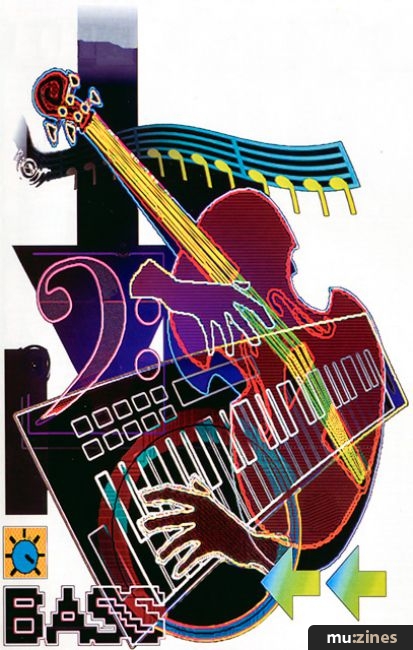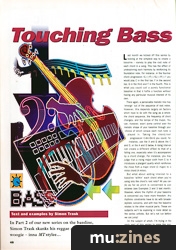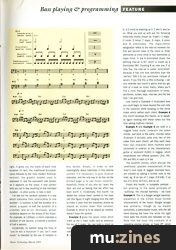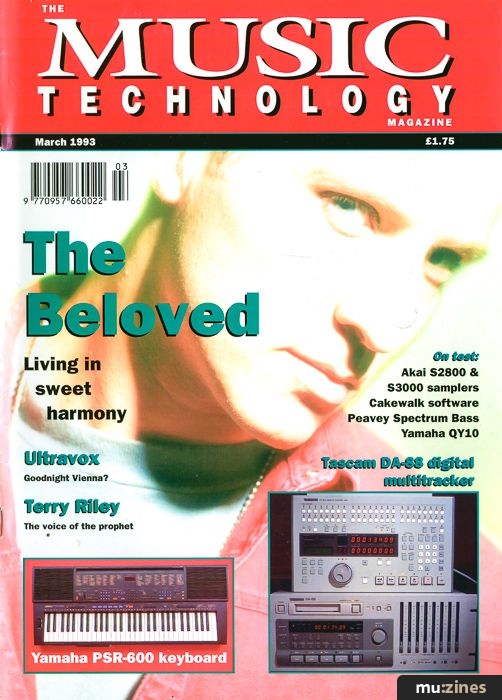Magazine Archive
Home -> Magazines -> Issues -> Articles in this issue -> View
Touching Bass (Part 2) | |
Bass playing & programmingArticle from Music Technology, March 1993 | |
The low down on the down low
In Part 2 of our new series on the bassline, Simon Trask skanks his reggae and boogies his woogie - inna MTstylee...

Last month we kicked off this series by looking at the simplest way to create a bassline - namely to play the root note of each chord in a song. This has the effect of underpinning each harmony by reinforcing its foundation note. For instance, in the four-bar chord progression C-F-G-F you would play C in the first bar, F in the second bar, G in the third and F in the fourth. This is what you could call a purely functional bassline in that it fulfils a function without having any particular musical interest of its own.
There again, a perceivable melodic line may 'emerge' out of the sequence of root notes. However, this depends largely on factors which have to do with the song as a whole: the chord sequence, the frequency of chord changes, and the tempo of the music. You can, however, exert some control over the melodic shape of your bassline through your choice of which octave each root note is played in. Taking the chord/root progression C-Am-Dm-G you could, for instance, use the A and G above the C and D, or the A and G below. A rising interval can create a different effect to that of a falling one, especially when it's accompanied by a chord change. For instance, you may judge that a rising major sixth from C to A introduces a plangent quality which reinforces the move from a major chord (C major) to a minor chord (A minor).
But what about adding interest to a bassline 'within' each chord when you're using only the chord's root note? All you can do as far as pitch is concerned is use octaves (see Examples 2 and 3 last month). However, where the rhythm of your bassline is concerned you have more freedom. Any rhythmic constraints have to do with broader stylistic concerns, and with how the bassline relates to the other musical parts. These are subjects we'll be exploring in more detail as the series unfolds. But let's not run before we can jump!
On the subject of which, I'm trying in the early part of this series to ease the non-reading musicians among you into reading music notation - which is where this month's Example 1 comes in. Reading from left to right, it gives you the name of each note duration (in fact, the traditional European name followed by the more modern American version), the graphic symbol used to represent it, and the equivalent rest symbol as it appears on the stave. A rest symbol tells you not to play anything for the indicated duration - in other words, to take a rest!
I've laid out the duration symbols in a way which indicates their relationship to one another - a crotchet is half the duration of a minim, a quaver is half the duration of a crotchet, and so on. Obviously, actual durations depend on the tempo of the music. For example, at 120bpm, a minim indicates a duration of one second, a crotchet a duration of half a second.
Incidentally, no subtext along the lines of "you're not a musician if you can't read music" is intended by the use of notation in this series. Simply, in order to talk meaningfully about basslines in this tutorial context it's necessary to give musical examples, and the only way to do this via the printed page is to use music notation. Hopefully, those of you who do 'learn the dots' will end up feeling that the effort has been worth it. Incidentally, this month I've added the 'octave lower' symbol to the bass clef (the figure of eight hanging from the clef) to make it clear that the basslines should be played an octave lower than notated. Example 6, which is to be played as notated, doesn't have the symbol.
Example 2 gives the seven notes which make up the C major scale, and by extension the key of C major. You can build a chord on each of these notes by 'stacking up' alternate notes of the scale. As you can see in Example 3, you get a C chord by stacking up C, E and G, a D chord by stacking up D, F and A, and so on. What you end up with are the following three-note chords (known as 'triads'): C major, D minor, E minor, F major, G major, A minor and B diminished. The major/minor designation refers to the interval between the first and second notes of the chord ie. three semitones (a minor third) or four semitones (a major third). In the B diminished chord, the defining interval is B-F, which is known as a diminished fifth. Counting B as note one, F is note five; the interval is called 'diminished' because it has one less semitone than the 'perfect' fifth C-G (six semitones instead of seven). If you find this a little confusing, I can only reiterate last month's advice that you get hold of a book on music theory, where you'll find a more thorough explanation of tones, semitones, scales, keys, intervals and the like than I can give here.
Last month's Example 4 illustrated how you could begin to move beyond the root note in the bassline while keeping to the three notes which define each chord. Example 4 this month develops this theme, so to speak, by again sticking with these notes but this time adding rhythmic interest.
Example 4 and Example 5 are both in a reggae bass style, underpin the same chords, and stick to the same chordal notes (Example 5 actually uses only two of the notes from each chord), yet they each have their own character. Both rhythms were conceived in relation to the characteristic guitar or keyboard rhythm in reggae, which emphasises the offbeat quavers (2nd, 4th, 6th and 8th) in each 4/4 bar.
The seventh chords, which provide the 'prettiness' quotient characteristic of the lover's rock style of reggae intended here, are created by adding a further note to the triad, eg. B on top of C major (C-E-G-B), C on top of D minor (D-F-A-C), and so on.
Finally this month, in complete contrast - but sticking to the same principle of 'outlining' the chordal harmony - we have Example 6. This is a boogie woogie bassline, presented in the 12-bar blues format characteristic of the music. Boogie woogie was primarily, though by no means exclusively, a piano-based music, with the left hand playing the bass line while the right hand adds the chords and melodies on top. Note that the bass line consists of a repeating one-bar phrase, or 'bass riff, which is transposed to fit the chord it underpins. Watch out for more boogie woogie basslines to come - how can you resist?

Series - "Touching Bass"
Read the next part in this series:
Touching Bass (Part 3)
(MT Apr 93)
All parts in this series:
Part 1 | Part 2 (Viewing) | Part 3 | Part 4 | Part 5 | Part 6 | Part 7 | Part 8 | Part 9 | Part 10 | Part 11
More with this topic
 What It All Means - Music |
Modes And Scales |
Chord of the Month - Keyboards |
Mind Over Music |
Chord |
Coverage - Fine Young Cannibals - Funny How Love Is |
Chords We Have Loved - Keyboards |
Coverage - Prince - Kiss |
Outside Of C - ...and left hand keyboard techniques |
Coverage - ZZ Top - Sharp Dressed Man |
Synth Sense |
Beyond E Major (Part 1) |
Browse by Topic:
Music Theory
Publisher: Music Technology - Music Maker Publications (UK), Future Publishing.
The current copyright owner/s of this content may differ from the originally published copyright notice.
More details on copyright ownership...
Topic:
Music Theory
Series:
Touching Bass
Part 1 | Part 2 (Viewing) | Part 3 | Part 4 | Part 5 | Part 6 | Part 7 | Part 8 | Part 9 | Part 10 | Part 11
Feature by Simon Trask
Help Support The Things You Love
mu:zines is the result of thousands of hours of effort, and will require many thousands more going forward to reach our goals of getting all this content online.
If you value this resource, you can support this project - it really helps!
Donations for October 2025
Issues donated this month: 0
New issues that have been donated or scanned for us this month.
Funds donated this month: £0.00
All donations and support are gratefully appreciated - thank you.
Magazines Needed - Can You Help?
Do you have any of these magazine issues?
If so, and you can donate, lend or scan them to help complete our archive, please get in touch via the Contribute page - thanks!
















